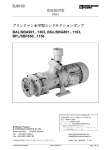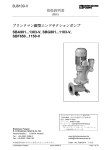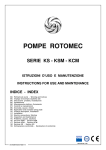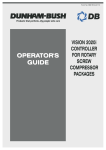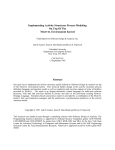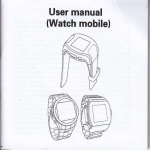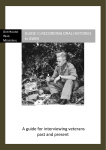Download 3rd Quarter 2010 - Brooks Equipment
Transcript
Volume 9, Issue 3 3rd Quarter 2010 An Update for Our Customers Te l . 8 0 0 . 8 2 6 . 3 4 7 3 • w w w. b r o o k s e q u i p m e n t . c o m • w w w. f i r e e x t i n g u i s h e r. c o m INSIDE Message From the President In the News................................. 2 Safety Tip for Extinguisher Placement................................ 2 External Maintenance of Dry Chemical Extinguishers........... 3 Extinguisher Pressure Gauge Replacement............................. 4 NFPA Safety Alert Regarding Antifreeze in Residential........ 5 NFPA Fire Prevention Week........ 6 Employee Spotlight..................... 7 Behind the Scenes....................... 7 Product Gallery......................... 8 Events E-Light Seminars september 23 - Norwalk, CA 23 - Elk Grove Village, IL OCTOBER 14 - Rochester, NY 21 - San Francisco, CA NOVEMBER 11 - Charleston, SC 18 - San Antonio, TX To register, visit www.brooksequipment.com Dear Valued Brooks Customer, Autumn is just around the corner. That means cooler temperatures and beautiful fall foliage are close behind. Quite a break from the 90-plus degrees most of us endured for what seemed like ever. Fall though, ushers in a number of things, not just cooler weather. October hosts NFPA’s Fire Prevention Week, starting on the third and running through the ninth of the month. You can read all about this year’s theme on page 6. It covers a lot of great information, including valuable tips and statistics on smoke alarms. Be sure to test your smoke and CO alarms and install new batteries while you’re at it. With the change of Seasons, there’s no better time than the present to start ordering your 2011 Custom-Imprinted Extinguisher Service Tags. Remember, you have to order them by October 11th to guarantee delivery by January 1, 2011. (See page 8 for more information and how to order.) This is also a great time to place your order for Custom Engraved Signs. These signs come in a number of colors with either pre-drilled holes or adhesive backs for easy mounting. You can read more about Custom Engraved Signs on page 8, too. Finally, this issue of Hot Topics explores a lot of other important topics. From in-depth articles on External Maintenance on Dry Chemical Extinguishers to an investigative piece on “using antifreeze in residential sprinklers”, Brooks brings you what’s relevant in our industry. Besides the thousands of original OEM parts and products that we carry, Brooks offers the best services and best customer care in the business. And, we’ve been doing it for almost 70 years. There’s no place on the planet for you to learn, shop and to get to know the business better than Brooks Equipment – I guarantee it. Call or email us any time at 800.826.3473 or [email protected]. Thank you for choosing Brooks. Sincerely, Quote “In the middle of difficulty lies opportunity.” ~ Albert Einstein Tim Foughty President IN THE NEWS Delta Pilot Puts Out Cockpit Fire Atlanta, GA - A Delta plane made an emergency landing at Hartsfield-Jackson International Airport in Atlanta over the weekend after a pilot reported an electrical smell in the cockpit. A "very minor" fire was put out by the pilot, after he landed the plane, Atlanta City Fire Department Capt. James Dorsey told CNN. The MD-88 had 107 passengers and five crew members aboard and was headed from Atlanta to Hartford, Connecticut. No injuries were reported in the incident. A Delta spokesman said the pilots smelled something unusual and decided to return to Atlanta. He says the crew used an extinguisher to put out the fire, which occurred after the plane landed and as it was holding to taxi. Delta is investigating the cause, which was related to electrical equipment. The carrier is also assessing the damage to the plane, according to the spokesman. F Opelika Fire Department Battles Two Local Fires, No Injuries Reported Opelika, Alabama - The Opelika Fire Department responded to its 24th and 25th structure fires of the year on Monday. The first call firefighters received came at 8:15 a.m. from Ashton Way Apartments in the 200 block of Samford Avenue. “The occupants of the home, who were present at the time of the fire, were preparing food in an oven and thought that they’d turned it off when they actually hadn't,” said OFD Capt. Scott McBurney. The fire spread to the kitchen cabinets of the home, which the occupants were able to extinguish. Firefighters remained on the scene approximately 40 minutes clearing the apartment of smoke, McBurney said. Later that same day at about 4 p.m., the OFD was called to a residence in the 1500 block of Pine Haven Court. “The occupants of the residence who were home at the time of the fire, reportedly smelled smoke and discovered a small fire in the attic of the home,” McBurney said. Using a fire extinguisher, the occupant of the home was able to contain the fire to the attic until firefighters arrived, said McBurney. The home sustained moderate fire damage to its attic with water and smoke damage throughout the rest of the structure, said McBurney. F Feature Safety Tip For Extinguisher Placement Halogenated Agent Extinguisher Safety Information By Mark Conroy UL requires that the nameplates on extinguishers containing halogenated agents (halons and halocarbons) be provided with safety information. This nameplate information is based on a weight-by-volume calculation to make sure that the agent’s safe exposure guidelines are not exceeded. The main purpose of the information is so the extinguisher user is not subjected to overexposure of the extinguishing agent vapors while discharging an extinguisher into a confined space. The UL minimum volume requirement for confined spaces is based on exposure to the agent in the absence of a fire and does not include 2 • HOT TOPICS considerations for fire and the agent decomposition products. The placement of extinguishers containing halogenated agents must therefore conform to this minimum confined space volume criteria. To calculate the volume of a space to be protected with a halogenated agent extinguisher, simply multiply the length by the width by the height. For example, if you have a room that is 10' by 12', with a 9' high ceiling, the calculation would be as follows: 10' x 12' x 9' = 1,080 cu. ft. When you place an extinguisher, this calculation should always be performed. Make sure too, that the cubic feet that you’ve calculated exceeds the minimum volume (cubic feet) permitted on the extinguisher’s nameplate. The property owner should be made aware of this nameplate information for the safety of the end user. F The above article is the opinion of the author and does not necessarily represent the position of a NFPA technical committee or the NFPA and may not be considered to be or relied upon as such. Mark Conroy is an engineer with Brooks Equipment Company and a principal member of the NFPA Technical Committee on Portable Fire Extinguishers. Copyright 2010, all rights reserved. Feature External Maintenance of Dry Chemical Extinguishers By Mark Conroy Most handheld portable fire extinguishers in buildings are rechargeable, stored-pressure dry chemical extinguishers. These extinguishers require annual external maintenance examinations. An internal maintenance examination is only required at the 6-year maintenance interval and the 12-year hydrostatic test interval. The cycle of external maintenance, internal maintenance, and hydrostatic testing is repeated for the service life of the extinguisher to ensure the safety of the user and the reliability of the device. Annual external maintenance of these extinguishers is necessary so that a number of critical components can be examined and repaired (if necessary) in order to make the fire extinguisher ready for use during a fire emergency. Where repairs are not appropriate, the extinguisher is replaced. When the external maintenance is performed correctly and completely on an annual basis and internal maintenance and hydrostatic testing are conducted on schedule, the maximum level of assurance that the extinguisher will work (as designed) to suppress or extinguish an unwanted fire is provided. The responsibility for establishing a contract for portable fire extinguisher maintenance falls on the building owner, the owner’s designated agent or the tenant of the building where fire extinguishers are located. Once the contract is established, performing maintenance correctly and at the right intervals normally is the responsibility of the fire equipment distributor. The actual task of extinguisher maintenance is assigned to a technician that understands how to examine the extinguishers and to take any necessary corrective action. The technician performing the maintenance relies on the extinguisher manufacturer's service manual for specific information on external examinations. The manuals also contain cautions and warnings so that the technician performs the tasks safely. Generally, the same external examination procedures are followed for all rechargeable, storedpressure dry chemical extinguishers. The practice has been standardized and the complete list of items to be examined has been added to the 2010 edition of NFPA 10, Standard for Portable Fire Extinguishers. General Procedures for Annual External Maintenance The extinguisher is removed from the hanger or cabinet and checked for damage. A broken or deformed verificationof-service collar indicates a suspect extinguisher that must be taken out of service for full maintenance, which includes internal examination. The hanger must be the one designed for the extinguisher. If it is identified as the wrong hanger or is damaged, the hanger is replaced. Extinguisher height and hanger mounting hardware are also examined. Incorrectly installed or loose hangers are removed. The hanger must then be properly located and securely re-attached at the correct height. Cabinets are checked for damage and proper operation. Auxiliary components such as “break glass devices” must be checked to make sure they are the proper ones for the cabinet and readily available for use. The operating instructions label on the extinguisher is examined to confirm that it is the right one and it is securely attached to the extinguisher. The label must not be faded and must be in a condition in which it is clearly legible and will not come off easily. Also, the location of the label is evaluated to make sure the instructions will be facing outward when the extinguisher is returned to its hanger or cabinet. Problematic operating instructions labels are replaced. Any extinguishers that are subject to recall or have become obsolete due to safety concerns are removed from service. Extinguishers that are considered obsolete are listed in Section 4.4 of NFPA 10. The service technician reviews the maintenance and hydrostatic test records. Any extinguishers due for the 6-year teardown or hydrostatic testing are removed so that the work can be done. Any fire extinguisher that is removed from a building for repair, internal maintenance, or hydrostatic testing must be replaced by a fire extinguisher that is appropriate and rated for the hazard. A thorough examination of the condition of the extinguisher cylinder is conducted to check for corrosion, dents, gouges, and repairs. If corrosion, dents, or gouges are identified, an evaluation is made to determine whether the problem areas are within tolerable ranges or whether the extinguisher needs to be replaced. Tolerances for corrosion, dents, and gouges are provided in NFPA 10. Any extinguisher that shows signs of being repaired such as welding is replaced. An evaluation is conducted as the pull pin is being removed. A pin that does not slide out easily is replaced. Additionally, the pin and the slot are examined. A bent or corroded pin is replaced. With the pin out, the valve stem is examined to make sure that it protrudes out the top of the valve and is correctly extended. The valve stem is also checked for corrosion and damage. A valve stem problem typically necessitates the teardown of the extinguisher and the replacement of the valve stem. The handle and the actuation lever are examined. Bent or corroded handles or levers and rivets that cause the lever to stick are reasons for extinguisher removal for repair. A new tamper seal is installed when the pull pin is inserted in the extinguisher lever. The new tamper seal is not only required, but it gives the building owner or a fire inspector a visual indication that the pull pin, valve stem, handle, and lever evaluations were most likely conducted during maintenance. The pressure gauge is checked to Continued on page 4 3rd Quarter 2010 • 3 Feature Extinguisher Pressure Gauge Replacement By Mark Conroy It is sometimes necessary to replace pressure gauges on extinguishers. All extinguisher pressure gauges in the Brooks catalog are UL recognized components listed for fire extinguishers. Beyond making sure of the proper component listing of the replacement gauge, there are three things that are checked to assure that the right replacement gauge is being used. It must match the charging (service) pressure, it must match the agent in the extinguisher and it must be compatible with the valve body material. Charging Pressure The gauge pressure must match the charging pressure. If the charging pressure for the extinguisher is 195psi, then the gauge must have “195” in the green area. You can find Continued from page 3 make sure the needle is in the operable range. The pressure gauge is examined to ensure it is not damaged or bent, or the face plate cracked. The technician also confirms that the pressure gauge matches the agent type and the nameplate’s operating pressure and verifies the gauge threads are compatible with the valve body material. An extinguisher with a problematic gauge is removed for replacement of the gauge. The extinguisher hose is removed and examined for cracks or deformation. The technician verifies that the hose is the correct one for the extinguisher model and that the hose assembly has no obstructions. Additionally, the condition of the hose assembly threads and couplings is assessed. While the hose is off, the valve port surfaces are examined for signs of leakage or 4 • HOT TOPICS the extinguisher charging pressure on the extinguisher nameplate or in the service manual. The gauge you are replacing may be the wrong one, so always match the extinguisher service pressure with the replacement gauge. Agent Type Marking All gauges are marked with the type of agent that is used in the extinguisher, so it is important to use the right replacement gauge. A dry chemical gauge will say “USE WITH DRY CHEMICAL ONLY”. A gauge that has the marking “USE WITH WATER, AFFF OR LOADED STREAM ONLY” can be used with any of these three agents. Compatibility with Valve Body Material Each gauge has a manufacturer’s code letter. Understanding the system is key for matching the gauge to the extinguisher valve body material. The valve body compatibility is indicated as follows: • Aluminum - A line above the gauge manufacturer’s code letter is a gauge for use with an aluminum valve body. corrosion that indicates the need for a teardown to correct these problems. Any improper, cracked, clogged or otherwise problematic hoses are replaced. The extinguisher must have a hose in good condition installed with one end fastened securely to the valve and the other end in the hose retention band that is securely and properly adjusted before it is returned to service. The extinguisher is weighed to verify the weight corresponds to the nameplate weight. A lower weight indicates a problem that necessitates recharging of the extinguisher. After the proper weight has been verified, the extinguisher is wiped clean of any dirt and contaminants. The maintenance is recorded on a new extinguisher tag or label, and the extinguisher is replaced on the hanger or returned to the cabinet. • Brass - A line below the manufacturer’s code letter is a gauge for use with brass valve body. • Aluminum or Brass - Lines above and below the manufacturer’s code letter or the absence of any line above or below the manufacturer’s code letter is a universal gauge for use with aluminum or brass valve bodies. An extinguisher gauge is relied upon to indicate that the unit is pressurized and ready to use in the event of a fire emergency. Using only correct replacement gauges provides a reasonable assurance that the gauges will provide correct readings during monthly or more frequent inspections. F The above article is the opinion of the author and does not necessarily represent the position of a NFPA technical committee or the NFPA and may not be considered to be or relied upon as such. Mark Conroy is an engineer with Brooks Equipment Company and a principal member of the NFPA Technical Committee on Portable Fire Extinguishers. Copyright 2010, all rights reserved. Ready For Use! Once the external maintenance is complete, the extinguisher is ready for use during a fire emergency. When periodic maintenance and hydrostatic testing are conducted correctly during the required regular intervals, the probability that the extinguisher will work as designed to suppress or extinguish an unwanted fire is maximized. F The above article is the opinion of the author and does not necessarily represent the position of a NFPA technical committee or the NFPA and may not be considered to be or relied upon as such. Mark Conroy is an engineer with Brooks Equipment Company and a principal member of the NFPA Technical Committee on Portable Fire Extinguishers. Copyright 2010, all rights reserved. Feature Additional Testing Completed on Antifreeze in Residential Sprinkler Systems The National Fire Protection Association (NFPA) Standards Council has banned the use of antifreeze solution in residential fire sprinkler systems for new construction until further action by the NFPA consensus standards committees, and the NFPA has issued a followup to its July 2010 safety alert to provide updated guidance on the use of antifreeze in new and existing residential sprinkler systems. The council action and updated alert follow new research that was conducted after a fire incident raised concerns about antifreeze solutions in residential sprinkler systems. The safety alert and additional information on this topic can be found at www.nfpa.org/antifreeze. Key findings from the new report were: • Antifreeze solutions with concentrations of propylene glycol exceeding 40% and concentrations of glycerin exceeding 50% have the potential to ignite when discharged through automatic sprinklers. • Both the 40% propylene glycol and 50% glycerin solutions demonstrated similar performance to that of water alone for fire control throughout the series of tests. • Based on the results of this research, antifreeze solutions of propylene glycol exceeding 40% and glycerin exceeding 50% are not appropriate for use in residential fire sprinkler systems. • Consideration should be given to reducing the acceptable concentrations of these antifreeze solutions by an appropriate safety factor. Based on the research, NFPA offered the following updated guidance on residential sprinklers systems: New Systems The NFPA standards prohibit the use of antifreeze in residential fire sprinklers in new construction following the August 16, 2010 issuance of tentative interim amendments (TIA) to NFPA 13, NFPA 13D and NFPA 13R. If you are putting in a new residential fire sprinkler system (including all NFPA 13D applications and the dwelling unit portions of NFPA 13 and NFPA 13R systems), refer to the latest editions of NFPA 13, NFPA 13D and NFPA 13R, as amended by TIAs 1000, 995, and 994. Existing Systems • Fire sprinklers are extremely effective fire protection devices, significantly reducing deaths, injuries and property loss from fire. These systems should not be disconnected. • Residential fire sprinklers, whenever possible, should not contain an antifreeze solution. • If you have, or are responsible for, an existing residential occupancy with a fire sprinkler system, contact a sprinkler contractor to check and see if there is antifreeze solution in the system. • If there is antifreeze solution in the system, determine if other means, such as insulation, can be used to provide adequate freeze protection. • If there is no viable alternative to antifreeze solutions, the NFPA recommends the following: - Use only propylene glycol or glycerin antifreeze solution. - The antifreeze solution should be the lowest possible concentration required for the needed freeze potential, but under no circumstance should the antifreeze solution exceed a maximum concentration of 40% of propylene glycol or a maximum concentration of 50% of glycerin. Consideration should be given to reducing these concentrations by an additional safety factor. -The antifreeze solution should only be a factory pre-mixed solution; use of factory pre-mixed solutions is essential to ensure the proper concentration level and solution integrity. Antifreeze solutions should only be used with the approval of the local authority having jurisdiction. F Reprinted from the NFPA's "Fire Sprinkler Initative®: Bringing Safety Home" Newsletter. “Great works are performed, not by strength, but perseverance.” ~ Samuel Johnson 3rd Quarter 2010 • 5 Feature NFPA Fire Prevention Week – October 3-9, 2010 The official theme for the 2010 Fire Prevention week is “Smoke Alarms: A Sound You Can Live With!” The theme is developed each year by the NFPA and this year Fire Prevention Week is scheduled for the week beginning October 3. Many people are complacent about smoke alarms in their homes because they already have at least one and feel adequately protected. During Fire Prevention Week fire safety professionals are encouraged to motivate people to take the necessary steps toward greater home fire safety. This year’s FPW campaign, “Smoke Alarms: A Sound You Can Live With!,” provides an ideal opportunity to educate the public about smoke alarm recommendations, and the campaign can serve as a powerful tool for motivating people to install smoke alarms, as needed, and to make sure they’re working and tested properly. More than half of home fire deaths in America occur in the five percent of homes with no smoke alarms. This year, we are hoping that people will share the knowledge when it comes to home fire safety and smoke alarms. Here is some information from the NFPA that you can share with others in your community. Smoke Alarm Basics Smoke alarms should be installed on every level of the home (including the basement), outside each sleeping area and inside each bedroom. Larger homes may need additional smoke alarms. Never remove or disable smoke alarms. Interconnection of smoke alarms is highly recommended; when one smoke alarm sounds, they all do. This is particularly important in larger or multistory homes where the sound from distant smoke alarms may be reduced to the point that it may not be loud enough to provide proper warning, especially for sleeping individuals. A licensed electrician can install hardwired multiple-station alarms. Wireless 6 • HOT TOPICS alarms, which manufacturers have more recently begun producing, can be installed by the homeowner. There are two types of smoke alarm technologies – ionization and photoelectric. An ionization smoke alarm is generally more responsive to flaming fires – like a pan fire or the smoke from cooking. A photoelectric alarm is generally more responsive to smoldering fires – like a cigarette, overheated wiring or something hot like a space heater. Install both types of alarms in your home or combination ionization and photoelectric alarms that take advantage of both technologies. Test smoke alarms at least monthly by pushing the test button. If an alarm “chirps,” warning the battery is low, replace the battery right away. All smoke alarms, including alarms that use 10-year batteries and those that are hard-wired alarms, should be replaced when they’re 10 years old (or sooner) if they do not respond properly when tested. Never remove or disable a smoke alarm. Smoke Alarm Statistics The NFPA provides the following smoke alarm statistics: • Smoke alarms are the residential fire safety success story of the past quarter century. • Each year, roughly 70 percent of home fire deaths result from fires in homes with no smoke alarms or no working smoke alarms. • Homes with smoke alarms (whether or not they are operational) typically have a death rate that is 40 to 50 percent less than the rate for homes without alarms. • If every home had working smoke alarms, U.S. home fire deaths would decrease by an estimated 36 percent, resulting in an estimated 1,120 lives saved per year. • Smoke alarms fail most of the time because of missing, disconnected or dead batteries. Know Where to Install Smoke Alarms The NFPA provides the following installation tips: • Install smoke alarms on every level of the home, including the basement, making sure that there is an alarm outside every separate sleeping area. • In addition to installing alarms on every level and outside the sleeping areas, it’s a good idea to install smoke alarms in all bedrooms. • For manufactured (mobile) homes, install a smoke alarm outside of each sleeping area and inside of each bedroom. • If someone in the home is deaf or hard of hearing, consider installing an alarm that combines flashing lights, vibration and/or sound. • Mount smoke alarms high on walls or ceilings (remember, smoke rises). Ceiling mounted alarms should be installed at least four inches away from the nearest wall; wall-mounted alarms should be installed four to 12 inches away from the ceiling. • If you have ceilings that are pitched, install the alarm near the ceiling’s highest point. • Don’t install smoke alarms near windows, doors or ducts where drafts might interfere with their operation. • Smoke alarms should not be installed in kitchens, bathrooms or garages. F Source: NFPA employee spotlight Robert Campbell Holds the Secret to Running Cincinnati’s Warehouse This November, Robert Campbell will celebrate 20 years with Brooks Equipment and in those years he has climbed the ranks, learned about managing a great team and figured out how to put his warehouse in the number one slot at Brooks Equipment. Two decades ago, Robert started at Brooks as an employee in the Cincinnati warehouse. Today, he is the Warehouse Manager and has held that position for almost 13 years. “It’s always an adventure [working here] – there truly is something new every day,” says Campbell about his typical day at work. He arrives very early in the morning, anywhere between 6:00 or 6:30 a.m., and he doesn't stop working until everything is done. “I interact with will-call customers, who come in and pick up their product. Most of our customers are regulars and have been coming around for about 20 years, so we have developed many work-related friendships.” How does Robert run such a tight ship? “It is constant work, there is not a lot of down time but I always stay on the move,” says Campbell. ” Down in Charlotte they think I‘m a drill sergeant in the way I run the warehouse. They laugh about it because they think I have my guys standing at attention,” says Campbell with a chuckle. “But it’s not quite like that.” So, what exactly is his secret? “I’m a perfectionist. I like things perfect, running smooth and easy. Maybe it has to do with my method of managing employees – I have a really good core of guys, they know what they are doing and they understand me,” says Campbell. “The highlight of my career at Brooks is holding the #1 warehouse ranking spot almost every year since Brooks started ranking warehouses. Everybody is after me!" he laughs. The Brooks warehouse ranking system is based on a combination of many different factors – sales, orders shipped, mistakes, inventory, etc., and has been going on for about seven years. "It's a neat thing." Outside of work, Robert spends a lot of time on sports. “I play basketball to keep my sanity and take out my frustrations, plus I have two daughters with whom I spend a lot of time and I coach their three teams – baseball, basketball and soccer.” Robert looks back and tries to remember how he happened upon this successful time at Brooks and says simply, “I got extremely lucky.” He adds a final message for customers – “I think our customers are a really good group of people, they are very friendly. I appreciate their business and I know the company appreciates their business. If they ever need anything, they can rely on me to help them out in any matter.” F Behind the scenes A Chief’s Perspective By Darrell W. Harguth I am sure that we have all heard the old saying, “IF IT AIN’T BROKE, DON’T FIX IT.” Currently, in California we have a proposed Assembly Bill No. 660. What is it? This Bill, if passed, would require anyone working on a fire suppression system, of any type, to complete an Apprenticeship Program for Sprinkler Fitting. This program involves approximately 8,000 hours of field work, as well as 700 hours of provable training. AB 660 would require workers doing servicing, testing and routine maintenance on any of these systems to go through the above-mentioned training. Why would anyone want to change the current system which is working so well? The current California State Fire Marshal’s Regulations for Fire Protection Systems has an exemplary record of effectiveness and reliability. It appears that some group is trying to gain control of all the fire protection systems with regards to installation, inspection and maintenance. CALSAFE (California Association of Life Safety and Fire Equipment), who is leading the charge to defeat this Bill, as are others, has had an analyst do some preliminary calculations on the financial impact of the current fire protection industry, should this Bill pass. The findings show that the cost to the systems owners could increase a minimum of thirty percent. This cost increase could be disastrous, especially in our current financial times, particularly to tax-funded facilities such as schools, universities, hospitals and other state and local facilities. In addition to California, I understand that other states are being presented with legislation similar to our AB 660. Many of us in fire protection may have a battle ahead! F 3rd Quarter 2010 • 7 Product Gallery For more information on these featured products, visit brooksequipment.com. 2011 Service tags – Order Now! New Custom-Imprinted Extinguisher Service Tags are printed on both sides with black ink on a coated 13pt stock with reinforced eyelets. Metal eyelets and/ or wire optional. 2011 is just around the corner. Don’t forget to order your tags by October 11th to guarantee delivery by January 1, 2011. Create a custom layout designed specifically for your needs! Add your company’s information and logo. Call Brooks Equipment for details 800-826-3473. sspsty nfwbk sspilB SSPCAFSTAG custom engraved signs Two exciting options available – plastic with pre-punched holes or plastic with adhesive back. •Custom made to your specifications – up to 432 square inches. • Seven different color schemes available. •Comes complete with pre-punched corner holes or adhesive backs. • Service your non-traditional sign needs with our custom signs up to 24" x 18". System Serviced in Accordance with NFPA17 or 17A and 96 by ABC Fire Systems (555) 555-5555 pre-punched adhesive back REMOTE PULL FOR HOOD #1 adhesive back brooks filter spacers Fire Extinguisher valves New New Brooks’ Filter Spacers fill in the uncovered plenum space that results when using standard size filters. Because custommade filters are expensive and sometimes hard to find, our stainless steel spacers fit the bill, and the space that’s not critical to air flow or system detection. Spacers are made of 20 gauge, 430 stainless steel and have a brushed finish. CO2 Valve for ½" neck steel cylinder without latch (BHV50) and 1" neck steel cylinder with latch (BHV100). BHV100 FGF425 8 • HOT TOPICS 2010 © Brooks Equipment Co. Inc. MEMBER AFSA • CALSAFE • FEDOT • FEMA • GAFSED • GBFAA • LLSSA • NAFED • NCFAA • NFPA • NFSA • ORFED • PAFED • SCSA









